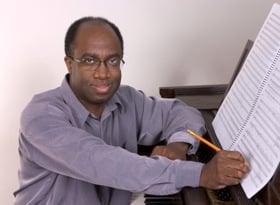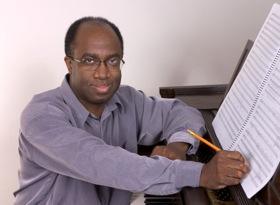
Friday’s concert at the Paramount Theatre left me unconvinced of the Oakland East Bay Symphony’s decision to pair two rarities by Erwin Schulhoff and Moisey Vainberg with Beethoven’s Eroica symphony. Although Beethoven received customary top billing, it was Schulhoff’s 1921 Suite for Chamber Orchestra and Vainberg’s 1967 Trumpet Concerto that formed the real interest of the program. These compositions, products of Central European Jewish composers reacting to a very brutal and ugly modernity, worked at avid cross-purposes with Beethoven’s paean “to the memory of a great man” laden with an abundance of historical and cultural baggage. Everything received fine performances, but the return from intermission gave me the impression that some sentient vapor had transported me through time to some other concert in the orchestra’s season.
Music Director Michael Morgan’s straightforward approach to Schulhoff’s Suite of jazzy dances (ragtime, shimmy, tango, and the like) underlined how tempting it is to see this music through Stravinskian goggles. While Stravinsky championed dryness and abhorred expression in his similarly titled works, Schulhoff’s music from the early 1920s far more resembles the subjective Expressionism of Austrian modernists such as Schoenberg, the theatrical modernism of Schuloff’s native Bohemia, and the jazz-tinged cabaret of Berlin nightlife. Although Morgan stodgily resisted the temptation to luxuriate in the obvious theatrical lilt of the instrumental solos in the “Valse Boston,” Schulhoff’s whimsical “shimmy” still brought chuckles from the audience. Oddly enough, the least-jazzy movement was the finale, titled “Jazz,” which sounded like recycled Ravel.
The concert’s high point was the performance of Vainberg’s Trumpet concerto by OEBS principal William Harvey (the Jewish-Russian-Polish composer’s name is also spelled “Mieczysław Weinberg”). Vainberg, who received his musical training in the Soviet Union, was a protégé of Shostakovich, and he has recently gained more attention since his 1968 holocaust opera, The Passenger, was produced in Germany in 2010 and by the English National Opera in September 2011. Vainberg’s music in every way resembles that of his friend and mentor.
The concert’s high point was the performance of Vainberg’s Trumpet concerto by OEBS principal William Harvey.
Harvey dashed off the never-ending succession of notes of the first movement, titled “Études,” with clean precision and presence. As in many Shostakovich works, Vainberg’s unprogrammatic music often seemed to say something. The second movement featured the full OEBS strings in a rich, extended recitative and gave principal flutist Alice Lenaghan a probing cadenza. Like Shostakovich’s final symphony, Vainberg’s finale quotes works by other composers for purposes that can only be described as deliberately inexplicable. In addition to the quotations from Mendelssohn, Mahler, Rimsky-Korsakov, Bizet, and Stravinsky, I also heard works by Borodin and Bartók.
Dark Side of Nationalism
As in Vainberg, Beethoven’s Eroica often seems to say something, but it is something quite different. In the context of Vainberg’s and Schulhoff’s lives, both displaced by Nazism, it implies something disturbing. To quote the official paper of the Sturmabteilung from 1937, “There is an enormous difference ... between the intoxicating sprit of the German waltz and the rhumba or swing. ... We gladly leave Kestenberger, Schönberg, and Stravinsky to the civilized and pretentious art circles abroad. ... We the people of Beethoven ... cannot and will not any longer allow one of the noblest blooms of cultural life to fall increasingly victim to degeneration. ... Here too the usual dichotomy between soul and body emerges, which is the mark of the Western Asiatic racial and cultural expression.” This is not to imply that Beethoven or the heroic figure of the Eroica knew about, endorsed, or sympathized with the dark side of nationalism, but simply to assert that such an association is now an inextricable part of the piece.
The OEBS gave a polished, driving account of the Eroica.
After hearing Vainberg’s and Schulhoff’s works, with their percussion batteries and modern spirit, Beethoven’s Eroica lost its revolutionary fire and its ability to surprise and enchant on its own. Aside from some timid passages from the horns, the OEBS gave a polished, driving account of the score, which Morgan insistently and constantly pushed forward. I wish he had intervened more forcefully in the musical flow to put his stamp on the work. For instance, my favorite section of the symphony is a tortured F-minor fugue midway through the funeral march. There are two counter-themes that the composer asks to be played short. The symphony is so familiar that, even though the orchestra played these correctly with a requisite degree of shortness, the notes almost have to be taken to a perverse extreme so that they may sound fresh and exciting. Morgan drove these on, but he did not drive them home.
My struggle to come to terms with Beethoven in this context was made happier when the attendant at the refreshment counter informed me that audience members at the Paramount were now allowed to return with their beverages to their seats in the auditorium. This is routinely permitted in European concert halls and subways, without incident, and I hope this enlightened policy continues in downtown Oakland.

